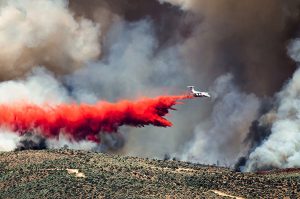 Despite California’s August cooldown, experts predict the wildfire threat is above normal heading into fall. As of September 17, at least 18 active fires are bringing destruction — from San Diego to the new blazes in Orange and Los Angeles counties all the way north to Humboldt County. The California Department of Industrial Relations (DIR) reminds employers to both monitor air quality levels and protect their employees when air quality is poor due to wildfires.
Despite California’s August cooldown, experts predict the wildfire threat is above normal heading into fall. As of September 17, at least 18 active fires are bringing destruction — from San Diego to the new blazes in Orange and Los Angeles counties all the way north to Humboldt County. The California Department of Industrial Relations (DIR) reminds employers to both monitor air quality levels and protect their employees when air quality is poor due to wildfires.
Not only detrimental to the areas with actual conflagrations, wildfires can also cause significant long-range air-quality hazards. Wildfire smoke contains harmful chemicals, gases and fine particles. These tiny inhalable particles, called PM2.5, are only about 2.5 micrometers wide — about 1/30 the width of a human hair — but they contain organic carbons that are very toxic if inhaled. Breathing these particles — even short term — can reduce lung function, worsen asthma or other existing heart and lung conditions, and cause coughing, wheezing and shortness of breath. Chronic inhalation of PM2.5 can even cause premature death for individuals with preexisting heart or lung conditions.
California employers with workplaces that cannot filter PM2.5 levels to 150 or less — those that can include enclosed buildings or structures where a mechanical ventilation system filters the air and the employer ensures windows, doors and other openings are kept closed — must follow the DIR’s Protection from Wildfire Smoke standard.
First, employers must monitor the Air Quality Index (AQI) by visiting the U.S. EPA’s AirNow, local air quality management district websites or by using their own instruments under Cal/OSHA’s requirements.
Then, if the AQI for PM2.5 is 151 or greater, employers must:
Inform employees of the AQI for PM2.5 and the protective measures available to them.
Provide effective training and instruction to all employees on the “Protection from Wildfire Smoke Information to Be Provided to Employees (Mandatory)” in section 5141.1 Appendix B.
Implement modifications to the workplace, if feasible, to reduce exposure, such as providing enclosed structures or vehicles where the air is filtered for employees to work in.
Implement practicable changes to work procedures or schedules, like changing the location where employees work or reducing the time they work outdoors or are exposed to unfiltered outdoor air.
Provide proper respiratory protection equipment, such as disposable respirators, for voluntary use. To filter out fine particles, respirators must be labeled N-95, N-99, N-100, R-95, P-95, P-99 or P-100, and must be labeled as approved by the U.S. National Institute for Occupational Safety and Health.
Additionally, if the AQI is 500 or more due to PM2.5, employees are required to use respirators that function sufficiently enough to bring the air that they’re breathing to an AQI of less than 151.
Finally, remember that employers can’t retaliate against workers for refusing to work in unsafe conditions, including evacuation zones.


